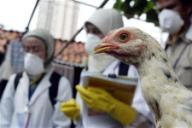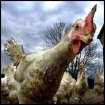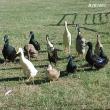Business and bird flu

BUSINESS
FLU FEARS: Big companies prepare for pandemic, but not everyone is ready
By JULIE JETTE
The Patriot Ledger
First, it was Y2K. Then it was potential for terrorist attacks in the wake of Sept. 11. Last fall, in many parts of the country, there was the threat of devastating hurricanes. Now, it’s a pandemic flu.
Businesses have always needed to plan for disasters. But if ever they were looking for incentive, the last several years have provided plenty of them.
But the challenges faced by businesses in the course of a pandemic flu could be substantially different than those posed by previously forecasted catastrophes.
The good news: There would likely be little damage to physical assets like buildings and infrastructure. The bad news: Public health officials are urging businesses to consider how they will operate - or how to conduct an orderly shut-down or curtailment of business - should 40 percent of their workforce be absent, potentially for weeks at a time.
Unlike weather-related events or all but the most cataclysmic terrorist attacks, most disasters tend to be localized and limited in time. If a flu pandemic strikes, it may well be regional, national or worldwide.
‘‘It’s being described as a global blizzard that could be 12 to 18 months, and that is not something business continuity planners (generally) plan for,’’ said Ann Beauchesne, a spokeswoman for the U.S. Chamber of Commerce in Washington. ‘‘Wherever ground zero is, it’s going to spread.’’
Beauchesne said the chamber believes most large, multi-national companies are well-prepared for a flu pandemic, in part because many have long had extensive disaster recovery and business continuity plans.
However, she said, it is less clear whether small- and mid-sized companies are adequately prepared.
‘‘The larger multinationals get it and have been doing (pandemic planning),’’ she said. ‘‘The small- to mid-sized companies need more information.’’
As part of its pandemic education effort, the U.S. Chamber - along with the Centers for Disease Control, the New England Council and several health plans - is hosting a half-day seminar on pandemic planning at the Landmark Center in Boston on Monday. The seminar is the first of a number of regional seminars the Chamber will hold with the CDC.
While larger companies may be more prepared for the pandemic, most aren’t sharing details about their strategies, saying they don’t want to reveal too much, given the sensitive nature of disaster planning.
‘‘Our specific plans are proprietary,’’ said Robert Keane, a spokesman for Quincy-based Stop & Shop Supermarket Co.
He did say the company’s primary goals are to get information quickly to customers and employees, and ‘‘also to keep our shelves stocked, especially with items our customers might need in any kind of pandemic.’’
He said the company is also meeting with the state Department of Public Health to prepare for various scenarios.
Boston-based State Street Corp., one of the South Shore’s largest employers, said it is prepared to shift work to other locations in its worldwide network of offices if one is particularly hard-hit by the flu.
The company also has information on the flu, how to avoid getting it, and explanations of health terms on its internal employee web site. It will also link that site to any travel restrictions that are announced by public health authorities.
Anne Marie McCaughey, head of business continuity planning for State Street, said the company is working on policies to address when and how infected employees will return to work, how to handle the absences of employees who may need to care for loved ones, and other absenteeism issues.
She said the company is also setting up systems to track absentee patterns closely. Officials hope they can perhaps get an early warning of a problem, or at know exactly what areas are being hit the hardest.
‘‘We’d like to at least be prepared and also to track how exactly this is affecting our business,’’ she said.
Like planning for any disaster, part of the challenge of planning for a pandemic is the fact that much of what may happen is difficult to predict.
Epidemiologists are confident there will be another flu pandemic. Flu pandemics have surfaced every 30 to 50 years for much of recorded history. They occur when a new strain of influenza virus to which humans have no natural immunity makes the evolutionary leap from animals to humans.
For starters, no one knows when or how the next pandemic flu will surface. Planning and worrying about the next pandemic has intensified, however, since the H5N1 virus began killing birds and poultry workers in Asia over the past two years. It’s possible that virus may never make the jump to one that is easily transmissible among humans, and that the next pandemic will be triggered by an entirely different virus.
Stephen Aldrich, CEO of Bio Economic Research Associates in Cambridge, a consulting firm that is helping clients plan for a pandemic, says the potential impact on industry of the H5N1 virus will be localized if it doesn’t evolve into a human-to-human flu. The poultry industry would be the first, and potentially hardest hit.
‘‘For most European countries, when the virus arrived and there was disease in birds, poultry demand dropped off significantly,’’ Aldrich said, adding that the estimated worldwide hit to the poultry industry is already $15 billion. He said the travel industry could also be affected if that strain of bird flu appears in a certain region of the country.
‘‘Certainly we can expect the media to advertise loudly the arrival of that particular strain of influenza in North America, and heightened fears could lead to local and relatively contained economic impact,’’ he said.
Considering that poultry-handling practices in the U.S. are far different than those in Asia, Aldrich said it is possible there won’t be any human cases here resulting from an H5N1 virus in poultry.
Effects of a human-to-human virus on the economy would be far more widespread, he said. But Aldrich said the approach individual businesses are taking to prepare for such an event varies broadly.
‘‘There’s a sort of ‘act of God’ mentality in some businesses,’’ he said. ‘‘And in other businesses, that’s not the idea at all (and) there’s a very proactive idea that this is something we can have an influence on and we should figure it out rationally.’’
BUSINESS CHECKLIST
The CDC has a checklist for businesses trying to prepare for a pandemic flu. Among the federal agency recommendations:
—Identify a pandemic coordinator or team with defined roles and responsibilities for preparedness and response planning. The planning process should include input from labor representatives.
—Develop and plan for scenarios likely to result in an increase or decrease in demand for your products or services during a pandemic.
—Establish policies for employee compensation and sick-leave absences unique to a pandemic, including policies on when a person who is no longer infectious can return to work.
—Develop and disseminate programs and materials covering signs of the flu, personal and family protection, and response strategies.
—Collaborate with federal, state, and local public health agencies and emergency responders to participate in their planning processes, share your pandemic plans, and understand their capabilities and plans.
The checklist can be found at pandemicflu.gov.
Julie Jette may be reached at jjette@ledger.com .
Copyright 2006 The Patriot Ledger
Transmitted Saturday, June 24, 2006



















